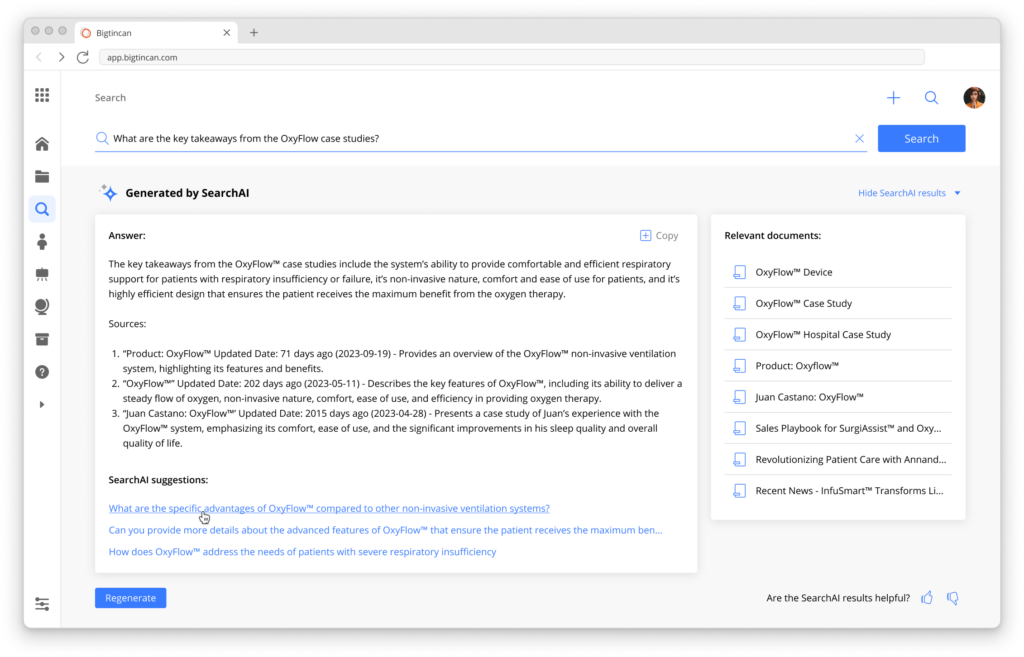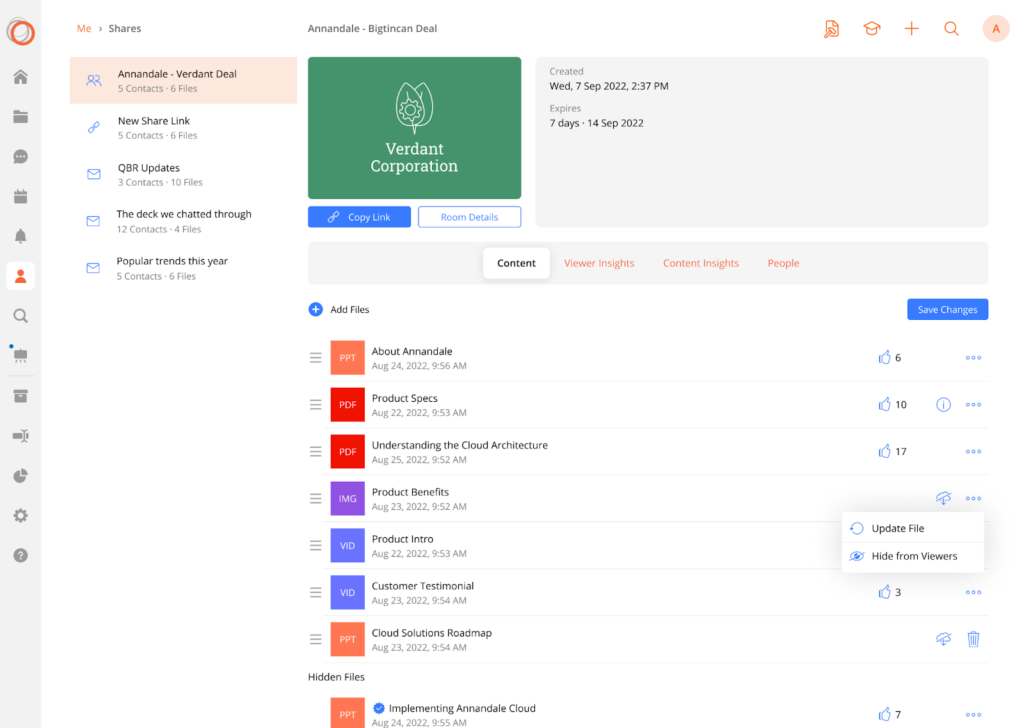Your marketing team just designed another batch of sales decks, product sheets, and case studies. The perfect companions for sales calls.
The problem: your sales reps can’t find half of it when they need it most.
Lack of content is hardly an issue — businesses push out resources daily, from blog posts to training videos. But quantity doesn’t always equal accessibility. Sales reps spend hours searching for that perfect pitch deck or product spec — time they could use to actually sell.
Shockingly, 65% of sales reps can’t find content to share with prospects. And enterprises? They’re squandering $2.3 million annually thanks to unused marketing content (Data: Kapost and Spotio).
The good news: AI tools are helping marketing teams to create, organize, and distribute their sales and marketing assets across departments more effectively.
Not using artificial intelligence for your marketing and sales content yet? Continue reading to learn why it’s time to make the change.
Why your current content process is broken
Your marketing teams are crushing it and sales teams are drowning in a sea of marketing-created documents, presentations, and videos. Yet, finding the right piece of content when you need it? Not happening…at least, not fast enough.
The average sales rep spends a heart-breaking 70% of their time on non-selling tasks, including searching for content. That’s nearly a full day each week wasted on hunting down those elusive product spec sheets and other mundane admin duties.
Meanwhile, your carefully crafted marketing materials are gathering digital dust — with around 60% of it going unused according to industry averages.
But even when your team finds the right content, they’re often unsure if it’s the latest version or how to best use it. Like whether they should use the same presentation for every customer or if there’s a customized version.
It’s also not ideal to read a 30-page document right before a sales call to gather important details about a new product. It takes too long and doesn’t guarantee finding the necessary information — just more time wasted.
And let’s not forget about marketing teams constantly fielding requests from sales reps asking, “Hey, do we have a case study for X industry?” or “Can you help me customize this presentation?”
Odds are they needed this content yesterday, putting serious pressure on marketing to deliver. The result? Frustrated sales reps, overworked marketers, and a high likelihood of poor quality content.
Now that we’ve explored a few of your all-too-familiar problems, let’s see how AI can help you solve them.
How AI makes content creation and discovery easier
Quickly putting together a sales deck for a big-name client. Browsing through HubSpot, Google Drive, and Salesforce for the right sales piece during a live demo.
These are issues you don’t want to deal with. At least, not without a tool that can speed up the process and make you look impressive.
AI is changing how we find and use content, making the process faster, smarter, and dare we say it, enjoyable.
Here’s how.
1. Talk to your content…literally
You’ve got a 50-page report and a meeting in 10 minutes. There’s no way you’ll get through the essential parts before then.
With AI, you no longer have to read long-winding reports (or any document) line-by-line. That’s old school.
The new school way is to allow AI to consume and extract all the key details in seconds. This tech summarizes long documents, helping sales reps quickly grasp key points before client meetings.
And it’s all done in a conversational style.
Just ask your AI assistant for what you need — a summary of the doc or a list of the relevant product specs related to a specific client — and it’ll create a bullet list or brief paragraph to get you up to speed.
Then during the sales call, if a question pops up that you can’t answer, just ask the AI to pull it from that document (or any other document in your content hub).
That’s the beauty of AI platforms — you can feed it thousands of pages of content, and it’ll find exactly what you need in seconds. Sometimes from an unlikely source you never would’ve thought to look at.
For example, here’s a look at how Bigtincan’s SearchAI tool acts as a personal SME, so salespeople get answers in seconds:

No need to learn prompting — just talk like you would to a fellow team member. In fact, Bigtincan’s GenieAI tools all come with prepopulated, configurable prompts so you can get what you need fast.
Bigtincan’s intelligent search functionality can dig deep into documents, not just titles and metadata, to find that perfect piece of content to answer your question.
Then, when it generates a response, it lists the sources (and other relevant documents), just in case you want to check them out.
Best of all — no hallucinations. Just pure facts from your company’s data.
2. Turn marketing content into interesting sales collateral
AI isn’t just the secret agent in your ear whispering all the correct things to say to convert prospective clients. It’s also cutting down the time it takes to create sales content. AI does this by taking your product sheets and guidelines and churning out compelling sales copy.
For instance, ask it to take a product spec sheet or case study and use that data to write a sales email that builds curiosity and urgency.
And it’s all on-brand since the AI learns from your writing style and branding guidelines you trained it on.
Here’s an example of Genie Assistant turning marketing content into a sales email:

Pro tip: Use AI-generated content as a starting point, then add your personal touch to maintain authenticity.
3. Create tailored Digital Sales Rooms in minutes
Don’t torture your clients with a one-hour “death by PowerPoint” meeting. If your sales team still relies on generic, one-size-fits-all presentations to infodump on prospects— that’s exactly what they’re doing.
This approach doesn’t address specific customer needs and can lead to bored audiences and lost deals.
What to do instead? Create customized Digital Sales Rooms (DSRs) where you can share all your best collateral with customers and let them browse the content (with the help of AI) to learn about your company on their own time.
These immersive environments offered by sales enablement software providers enhance the overall presentation and compel potential customers to act. Plus, clients and prospects can interact with the Digital Sales Rooms after the call to explore your company’s offerings.

These custom microsites are virtual spaces where sellers can share personalized content with prospects and customers. Each DSR is tailored to specific buyers or buying groups, providing personalized experiences that cater to individual needs and preferences.
Some DSRs (like Bigtincan’s) have artificial intelligence built into them for:
- Content summarization to help buyers learn about a product or service fast
- Q&A-style search to help clients get answers quickly
- Virtual assistance to help sales and prospects find documents and information without scouring through multiple documents
But the best thing about DSRs for revenue teams is their ability to track customer activity. The system collects data on buyer actions, providing valuable insights sellers can use to refine their approach and make more informed decisions throughout the sales process.

So, regularly review your analytics to see which assets clients review the most (or least) to tailor future content to their needs.
Pro tip: Update your content library with fresh, diverse materials to give the AI more options for creating impactful presentations and DSRs. In Bigtincan, you can update your marketing hub on the fly so your internal and external salespeople always have relevant, up-to-date information to share with prospects.
How to build your AI-powered content process
Ready to equip your marketing and sales teams with AI tools to speed up content processes and improve collaboration? Here’s a roadmap to get there.
Assess your current content workflow
- Are your sales reps constantly bugging marketing for “that one document” they can’t find?
- Does updating a single piece of content feel like herding cats?
- Is your content scattered across more platforms than you have fingers to count on?
- Do you break out in a cold sweat when asked about content ROI?
If you answered yes, then you need a tool to help you organize your content.
Spot the bottlenecks
Now, let’s pinpoint where things are going off the rails:
- Content creation: Are your writers staring at blank pages more often than they’re typing?
- Approval process: Does getting sign-off on a piece of content take longer than creating it?
- Distribution: Are your shiny new assets getting lost more than they’re found?
- Analytics: Can you tell which content is actually moving the needle, or are you just guessing?
If so, then you need an AI-powered enablement platform that makes your processes more fluid by removing these pipeline clogs.
Conduct a “what’s working” audit
Don’t just look at what’s wrong — take stock of what’s actually working:
- Which content pieces are your best sellers using on repeat?
- What types of content are prospects enjoying the most?
- Are there any workflows that are smooth as butter?
Then use this info to understand how to use AI to replicate those workflows and create more content that performs well.
Set your AI goals
Now, what do you want AI to do for you?
- Slash content creation time by 50%?
- Boost interest in content by 40%?
- Give your sales team psychic powers to know exactly what content to use when?
Okay, maybe not that last one. But you get the idea. Set clear, measurable goals that align with your overall business objectives.
Once you understand your needs, move on to finding the right AI platform to fulfill them.
See AI tools in action.
